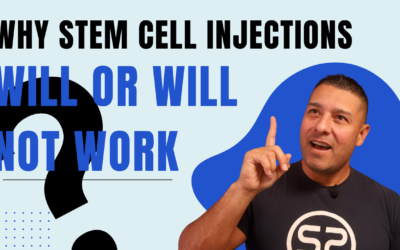“Rest Smart During Flare-Ups”
When recovering from stem cell therapy, it’s common to experience occasional flare-ups. Knowing how to manage these moments can be the difference between a smooth recovery and prolonged discomfort. In this blog, we’ll explore the most effective ways to rest during a flare-up and discuss how balancing different types of rest can support your recovery journey.
Understanding the Two Types of Rest
When we talk about rest, it’s important to distinguish between active rest and passive rest—two approaches with very different benefits:
- Active Rest:
This involves light, low-stress activities such as walking, gentle yoga, or easy pedaling on a stationary bike. The goal is to keep the body moving just enough to support recovery without adding additional strain. Active rest is not about pushing limits; instead, it’s about staying lightly engaged with movement to promote circulation and ease inflammation. - Passive Rest:
In contrast, passive rest means complete relaxation—think sitting on the couch, watching TV, or simply taking it easy without much physical effort. This type of rest is beneficial when your body needs a full recovery from more intense flare-ups that aren’t improving with movement.
What to Do During a Flare-Up
A flare-up can occur when you’ve overdone an activity while in recovery, such as lifting weights, playing sports, or walking more than usual. These flare-ups are normal as your body adjusts to the increased stress on healing tissues. So, what’s the best way to handle it?
- Start with Active Rest
When you first notice a flare-up, scale back your activities. For example, if your knees are inflamed, switch to light walking or low-resistance cycling to flush out the inflammation. If it’s an upper-body flare-up, skip your usual workout and stick to daily tasks like light housework or playing with your kids. - Monitor for 72 Hours
Active rest should ease symptoms within 72 hours. Continue with light activities during this time, avoiding strenuous exercises or sports that might aggravate the flare-up.
When to Switch to Passive Rest
If symptoms persist beyond 72 hours, it’s time to transition to passive rest. Spend a few days resting on the couch, watching Netflix, or relaxing until the flare-up subsides. If inflammation and discomfort persist for a week or longer, it may indicate a need to adjust your recovery plan.
The Importance of Professional Guidance
Prolonged flare-ups can signal that something in your recovery plan needs tweaking. A rehab professional can help you pinpoint what activity might have triggered the flare-up and guide you through the next steps. They’ll also adjust your activity level and ensure you are progressing safely toward your recovery goals.
Final Takeaway: Rest Smart During Flare-Ups
Yes, rest is essential during a flare-up, but the type of rest you choose matters. Start with active rest to maintain light movement and promote recovery. If symptoms don’t improve within 72 hours, switch to passive rest until you feel better. For longer flare-ups, consulting with a rehab professional is the best course of action.
Need More Guidance?
For more resources or assistance with your recovery, feel free to contact the Stem Cell Recovery Experts who specialize in stem cell rehabilitation. For more recovery tips and long-lasting results, feel free to call us (619-397-1391). We’re here to help!
If you found these tips helpful, don’t forget to subscribe to our YouTube channel (CLICK HERE) for weekly updates on how to recover safely and effectively after stem cell therapy.
If you’re a visual learner, check out the YouTube video I created on this topic:
Sincerely,
Dr. Chris Garcia, PT, DPT, SCS, CSCS, USAW

“Dr. Chris Garcia is the world-renowned expert on stem cell recovery, internationally recognized public speaker, and trusted advisor to physical therapists globally.”
The Dangers of a DIY Stem Cell Recovery Program
"The Dangers of a DIY Stem Cell Recovery"When it comes to stem cell recovery, many people believe they can manage the process on their own. After all, if you’re active and have successfully recovered from past injuries without professional guidance, why not do the...
When Can I Start to Jog After Stem Cell Injections?
"When Can I Start to Jog After Stem Cell Injections" If you miss running and are wondering when it’s safe to start jogging after stem cell injections, you’re not alone. This is a common question for individuals eager to return to their active lifestyle. The key is to...
Why Stem Cell Therapy Works for Some but Not Others
"Why Stem Cell Therapy Works for Some but Not Others" Stem cell therapy has been a breakthrough in modern medicine, offering hope for those with chronic pain or injuries. However, not everyone experiences the same results. Some patients see significant improvement,...



